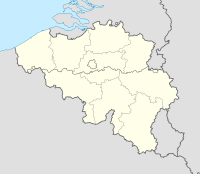| German phosgene attack | |||||||
|---|---|---|---|---|---|---|---|
| Part of Local operations December 1915 – June 1916 Western Front, in the First World War | |||||||
 Map of the Ypres district | |||||||
| |||||||
| Belligerents | |||||||
|
|
| ||||||
| Commanders and leaders | |||||||
| Erich von Falkenhayn | Douglas Haig | ||||||
| Strength | |||||||
|
Elements of 2 corps specialist Pioneer regiment | 2 divisions | ||||||
| Casualties and losses | |||||||
| Gas: 1,069 | |||||||
Ypres in West Flanders, Belgium | |||||||
The German phosgene attack of 19 December 1915 was the first use of phosgene gas against British troops by the German army. The gas attack took place at Wieltje, north-east of Ypres in Belgian Flanders on the Western Front in the First World War. German gas attacks on Allied troops had begun on 22 April 1915, during the Second Battle of Ypres using chlorine against French and Canadian units. The surprise led to the capture of much of the Ypres Salient, after which the effectiveness of gas as a weapon diminished, because the French and British introduced anti-gas measures and protective helmets. The German Nernst-Duisberg-Commission investigated the feasibility of adding the much more lethal phosgene to chlorine. Mixed chlorine and phosgene gas was used at the end of May 1915 against French troops and on Russian troops on the Eastern Front.
In December 1915, the 4th Army used the mixture of chlorine and phosgene against British troops in Flanders, during an attack at Wieltje near Ypres. Before the attack, the British had taken a prisoner who disclosed the plan and had also gleaned information from other sources; the divisions of VI Corps had been alerted from 15 December. The gas discharge on 19 December was accompanied by German raiding parties, most of which were engaged with small-arms fire, while they were attempting to cross no-man's land. British anti-gas precautions prevented a panic and a collapse of the defence, even though British anti-gas helmets had not been treated to repel phosgene. Only the 49th (West Riding) Division had a large number of gas casualties, when soldiers in reserve lines did not receive a warning in time to put on their helmets. A study by British medical authorities arrived at a figure of 1,069 gas casualties, 120 of which were fatal. After the operation, the Germans concluded that a breakthrough could not be achieved solely by the use of gas.
© MMXXIII Rich X Search. We shall prevail. All rights reserved. Rich X Search

